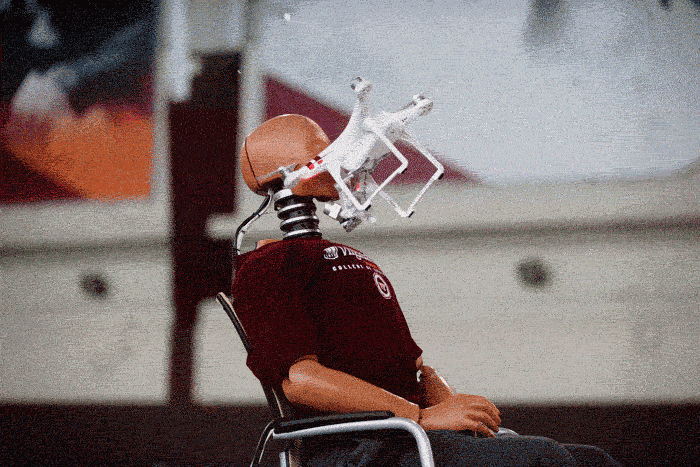
Robohub.org
Robohub Digest 03/17: #ERF2017, UK budget promises, International Women’s Day and drone safety issues

A quick, hassle-free way to stay on top of robotics news, our robotics digest is released on the first Monday of every month. Sign up to get it in your inbox.
Changing seasons
March is a month for change and new beginnings. The new UK Budget promised hundreds of millions of pounds to scientists and researchers to develop solutions to hi-tech challenges, including artificial intelligence and robotics, next generation batteries and new techniques for manufacturing medicines. The government is expected to allocate more than £500 million from the National Productivity Investment Fund so that UK companies might lead the way in the new technologies set to transform the world. £270 million will be earmarked for British businesses and universities to meet specific challenges with huge potential, which will include the use of robots to work in nuclear and offshore power generation, space and deep mining.
Intel announced plans to acquire Israel-based Mobileye, a developer of vision technology used in autonomous driving applications, for $15.3 billion. Mobileye share prices jumped from $47 to $61 (the tender offering price is $63.54) on the news, a 30% premium. The purchase marks the largest acquisition of an Israeli hi-tech company ever.
But it can’t be good news for everyone. Google’s robocar lawsuit could show Uber the red-light. Google’s Waymo is accusing the ridesharing giant of stealing a glut of its autonomous driving tech. Amidst political criticisms of CEO Travis Kalanick, and accusations of a sexist corporate culture, Uber must now worry about a legal dispute that could prove costly not only financially, but also kill its self-driving research and land more than one executive in prison.

And in a surprise move which shook Baidu’s stock, Andrew Ng, Baidu’s Chief Scientist resigned. Andrew was partially responsible for expanding Baidu’s AI activities into machine learning, driverless vehicles, advertising, maps, takeout delivery, and voice-activated search. Whilst Andrew’s departure might setback Baidu’s AI efforts, he’s likely to continue innovating the field of artificial intelligence. He commented:
I am excited to continue working toward the AI transformation of our society and the use of AI to make life better for everyone.
Meanwhile, a New York Times article reported that two leading economists—Daron Acemoglu of M.I.T. and Pascual Restrepo of Boston University—are providing evidence for robots winning the race for US jobs. They reported that for every robot per thousand workers in manufacturing and automation, up to six workers lost their jobs and wages fell by as much as three-fourths of a percent. It appears to be the first study to quantify large, direct, negative effects of robots, and is likely spark a lively debate.
Events and awards
March 8th was International Women’s Day. On Robohub, in honor of this, we republished our list of 25 women in robotics that you need to know about, and we discussed the lack of diversity and role models in STEM and the potential negative outcomes of bias and stereotyping in robotics and AI.

Researchers including MIT professor Daniela Rus (left) and research scientist Stephanie Gil (right) have developed a technique for preventing malicious hackers from commandeering robot teams’ communication networks. To verify the theoretical predictions, the researchers implemented their system using a battery of distributed Wi-Fi transmitters and an autonomous helicopter. Image: M. Scott Brauer.
In Edinburgh, over 800 leading scientists, companies, and policymakers working in robotics convened at the European Robotics Forum (#ERF2017), 22-24 March. This year’s theme was “Living and Working With Robots” with a focus on applications in manufacturing, disaster relief, agriculture, healthcare, assistive living, education, and mining. The 3-day programme featured keynotes, panel discussions, workshops, and plenty of robots roaming the exhibit floor. euRobotics hosted an Entrepreneurship and TechTransfer award at the event, where Fotokite and ‘Walk to Beat’ receive the top awards for innovative designs.
In other awards news: “Robot’s Delight – A Lyrical Exposition on Learning by Imitation from Human-Human Interaction” won Best Video at the 2017 ACM/IEEE International Conference on Human-Robot Interaction (HRI 2017). Watch the video below:
And events to look forward to: The World Robot Summit (WRS) website was launched earlier in the month on March 2nd. WRS will be a commercial robotics Expo and a series of robotics Challenges with the goal of bringing together experts from around the world to advance human focused robotics. The results of tenders for standard robot platforms for the competitions are being announced soon, and the first trials for competition teams should happen in summer 2017. You’ll be hearing all about it here on Robohub.
And this week, the Sands Expo Center in Las Vegas (5-7 April) will host ISC West 2017 in what they say is “the largest security industry trade show in the U.S.”, drawing an estimated 29,000+ security professionals. The show will feature ISC West’s first-ever Unmanned Security Expo focused on Unmanned Aerial Vehicles, Unmanned Ground Vehicles and various systems to support robotic technology. The Expo will include a fully functional flight cage and robotics demonstration area, booth exhibits and free education sessions.
New Research
As swathes of dead robots continue to litter the nuclear disaster site at Fukushima, UWE Bristol announced that it is part of a consortium which has received a £4.6 million grant to build a new generation of robots for use in nuclear sites. The funding from the Engineering and Physical Sciences Research Council will help develop smaller robotics technologies that will be able to operate autonomously and effectively in hazardous environments. Among the contributors will be Robohub contributor Alan Winfield, working alongside top experts from the University of Manchester and the University of Birmingham, as well as industrial partners Sellafield Ltd, EdF Energy, UKAEA and NuGen.
Meanwhile, a team from MIT’s Computer Science and Artificial Intelligence Laboratory (CSAIL) and Boston University is working on the problem of communicating specific commands from human to robot by creating a feedback system that lets people correct robot mistakes instantly with nothing more than their brains. Check out the video below.
As governments around the world (UK included) push for the introduction of 5G networks, the US based National Science Foundation (NSF) announced a $6.1 million, five-year award to accelerate fundamental research on wireless communication and networking technologies through the foundation’s Platforms for Advanced Wireless Research (PAWR) program. Award recipients US Ignite, Inc. and Northeastern University will collaborate with NSF and industry partners to establish and oversee multiple city-scale testing platforms across the United States. Smart cities are on the horizon.
New ‘bots on the block
Cobalt Robotics has launched their stylish security robot (below). The robot was designed by Yves Behar and as a fabric covered robot, and puts a new spin on soft robotics aesthetic. Behar’s goal was to create a robot that didn’t conform to Hollywood stereotypes but instead as an augmentation of human ability and an enhancement to the human environment. The Cobalt robot allows security to have a cost-effective, 24hour presence so security officers can remote in, see what’s going on, and look for intruders, amongst other employee focused tasks.
Hungry? The London-based company Starship Technologies has created six-wheeled self-driving delivery robots that will begin bringing customers Domino’s pizzas in Germany and the Netherlands. Starship, launched in July 2014 by two former Skype co-founders, Ahti Heinla and Janus Friis, will whisk pizzas to customers’ doors if they live within a one-mile radius of certain Dominos pizza shops in “select German and Dutch cities,” the company said in a statement.
Fancy a burger instead? You’ll soon be able to have one cooked by a robot at CaliBurger restaurants in the US and worldwide. Cali Group has partnered with Miso Robotics to develop Flippy the burger robot, which made its debut this March at the Pasadena, California CaliBurger.

Or perhaps it’s your appetite for art that needs sating? RoboThespian is currently starring in UK play Spillikin, a love story. In the poignant performance traveling throughout the UK, a robot is co-star and companion to the dementia suffering wife of a (now deceased) robot builder. The play explores very human themes about love, death, and disease, all handled extremely sensitively with RoboThespian playing a large role.
Good news if wheels just aren’t getting you there: Ghost Robotics—a leader in fast and lightweight direct-drive legged robots—announced recently that its Minitaur model has been updated with advanced reactive behaviors for navigating grass, rock, sand, snow and ice fields, urban objects and debris, and vertical terrain. They claim that their legged robots are superior to wheeled and tracked autonomous vehicles in real-world field applications. Take a look at the video below and see what you think:
Lastly, Since their “Best of CES” nominations and awards from Engadget, Wired, PC Magazine, and others., Kuri has been hard at work testing their social robot in lots of different homes, fine tuning hardware details and expanding software capabilities. Kuri’s voice command capabilities are growing. Today, if you say “hey Kuri, I love you”, Kuri responds with an “I love you too”, a dance and a light show. Progress. Expect more updates as Kuri nears shipping their first commercial ‘bots.
Aerial drones
For the first time, a drone operator was jailed for injuring a member of the public. The owner of an aerial photography business was sentenced to 30 days in jail after a drone he was operating knocked a woman unconscious during Seattle’s 2015 Pride Parade. Paul Skinner was found guilty of reckless endangerment by a judge at the Seattle Municipal Court. Related to this, anyone with an eye on flying drone safety and legislation should keep an eye on Virginia Tech’s visceral research, crashing drones into crash-test-dummies:

It’s becoming clear that if we are to incorporate drones into our lives in a good and safe way, we will probably need anti-drone instruments. On 4 December the TU Delft Micro Air Vehicle Lab (MAVLab) will host the first ever anti-drone competition: DroneClash. During this competition, participants use their own drone(s) to take down as many other drones as possible. They will also need to avoid a whole series of anti-drone interventions. Sounds fun!
Elsewhere, Snapchat owners Snap are rumored to be developing an aerial drone that could help Snap’s users take overhead videos and photographs, and then feed that visual data to the company. Meanwhile, Google has shuttered its own Titan drone project, whilst Facebook Inc. planned to ramp up test flights for its own experimental solar-powered glider. Facebook will begin launching a couple of flights a month of its Aquila drone, Jay Parikh, head of engineering and infrastructure, said in an interview this month at the Mobile World Congress in Barcelona.
In UK defense news, the Ministry of Defence’s Defence Equipment and Support Technology Office has awarded a contract to Italian company Leonardo Helicopters for Phase II of the rotary wing unmanned air system, capability concept demonstrator programme. Under the two-year, jointly-funded, research and development contract, Leonardo will also have to complete R&D works commenced under the RWUAS CCD Phase I programme held between 2013 and 2015.
Do it yourself?
Need some direction with your own robotics projects? Robohub’s got your back. This month, our contributors offered some fantastic tutorials, like Péter Fankhauser’s handy video tutorial course: Introduction to ROS. Or perhaps you need help programming your Sphero robot? If UAV land surveying missions are something you need a guiding hand with, SPH Engineering offered a guide to using its easy-to-use software, UgCS, for planning and flying UAV drone-survey missions. Stay tuned to Robohub for more to learn.
Upcoming events for April – May 2017
Automate: April 3-6, Chicago, IL.
Unmanned Security Expo: April 4-7, Las Vegas, NV.
Robobusiness Europe: April 19-21, The Hague, Netherlands.
ICCAR: April 22-24, Nagoya, Japan.
AUVSI Xponential: May 8-11, Dallas, TX.
Connected & Autonomous Vehicles: May 15-18, Santa Clara, CA.
Innarobo: May 16-18, Paris, France.
ICRA 2017: May 29-June 03, Singapore.
Missed any previous Digests? Click here to check them out.
tags: Robohub Digest




